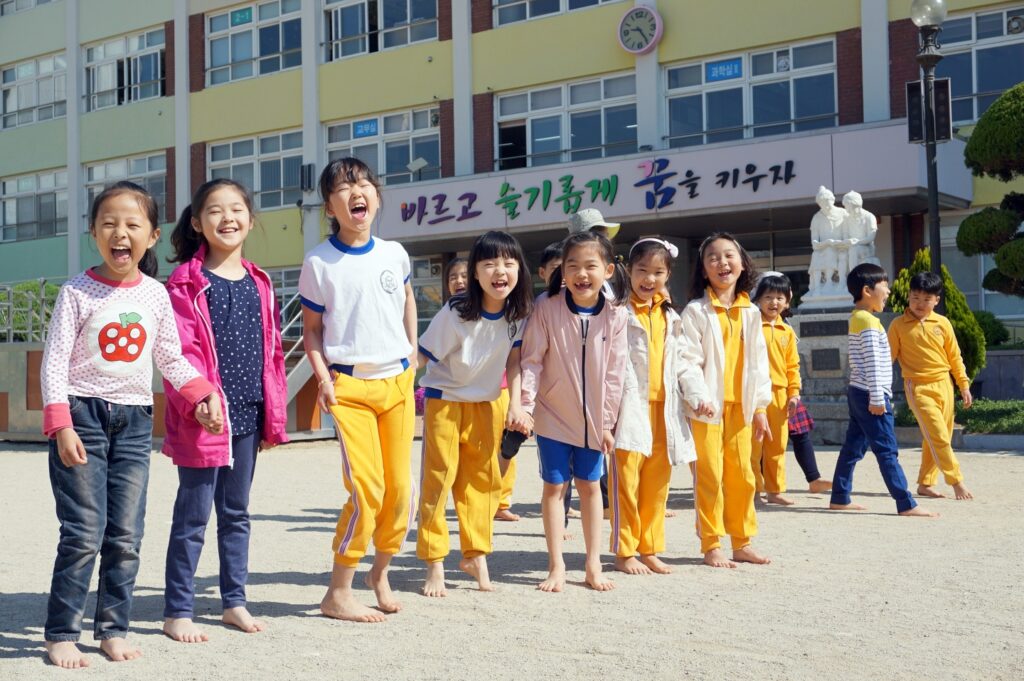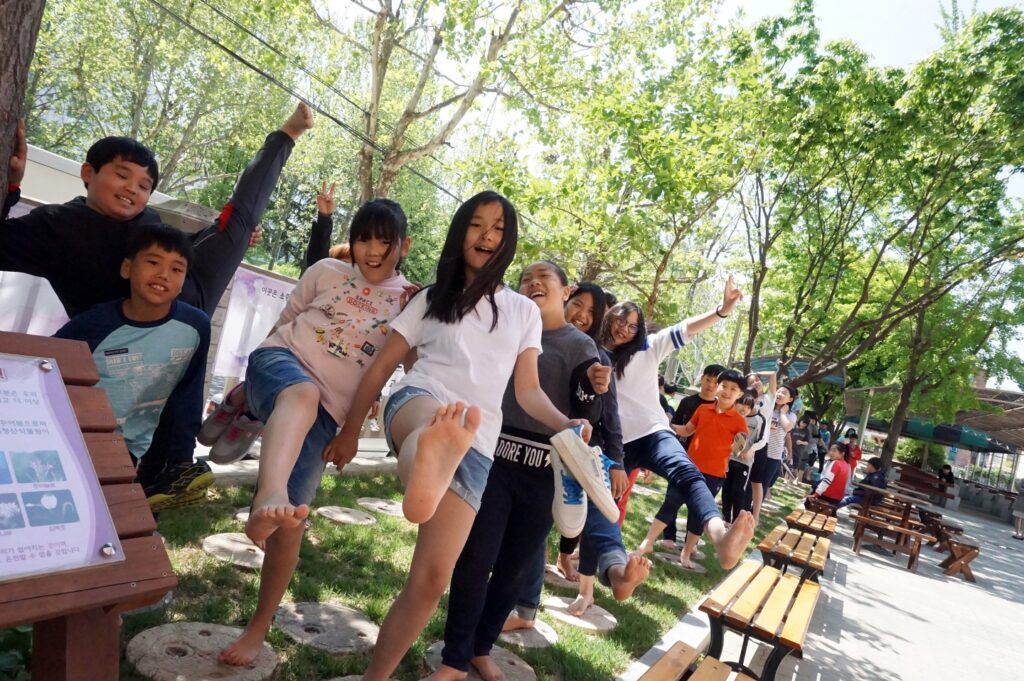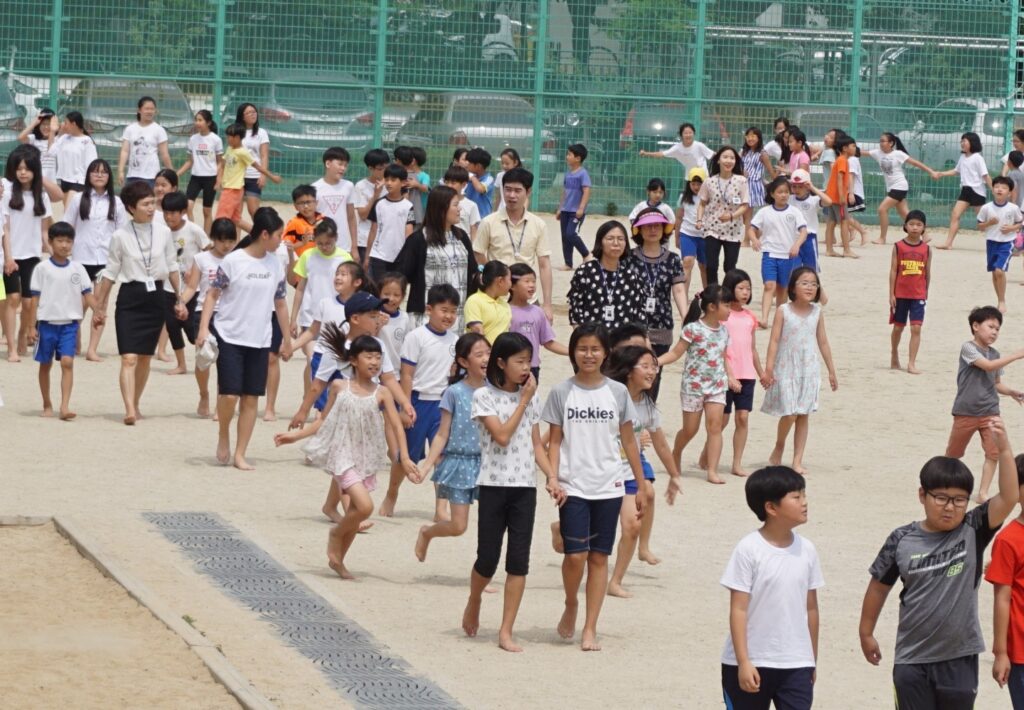
The first barefoot school: Gwancheon Elementary School’s barefoot walking project
Kids walking off the earth. One may precisely describe the young generations these days with this phrase. It also represents a screenshot of Korean society that has undergone compressed growth in a short period of time. When was the last time your kids, living in the asphalt-covered city, stepped on soil? While an increasing number of children are joining sport clubs, they are increasingly growing apart from nature. Living in a digital society where they exchange information on screen, what do our future generations need?
Daegu Gwangcheon Elementary School: the whole school walks barefoot
Led by Principal Lee Geum-nyeo, Gwancheon Elementary School in Daegu became famous when it started the barefoot walking program in 2018. Now the school is further growing as a leader in pioneering the potential of the brain. Having found that barefoot walking benefits the body and mind and activates the brain to boost concentration and creativity, they are aiming to teach students how to better use the brain.
We visited Gwancheon Elementary School on a rainy day. It started raining last night. We thought they would not walk barefoot on a day like this, but we were wrong. The school principal, Ms. Lee, showed us photos of them walking barefoot holding an umbrella from 8:30 to 9:10 a.m.
“I love watching them walk barefoot on a rainy day. They walk, with their shoes off, under a colorful shade of umbrellas. This also helps them make precious memories with peers.”
“Teachers, too, are barefoot in the classroom. Parents have great trust in us as they have witnessed their kids changing. More and more people, parents, and residents in the neighborhood, are coming to the school to walk barefoot. For them, we keep the gate open and lights on for an hour in the night.” The school is exerting a good influence on the community, said Ms. Lee.
The primary benefit of barefoot walking: health in body and mind
Gwancheon Elementary School has changed since 2017 when Ms. Lee introduced the barefoot walking program. The principal told us what kids speak about the change. “They find themselves better in health. They hardly catch a cold. Someone told me that he found his head clear.” This is demonstrated by statistical records on sick notes. The percentage of students who have skipped a day due to sickness dramatically dropped from 29.7% in 2015 and 21.2% in 2016 to lower than 15% in 2017.
Ms. Lee showed us written impressions of the barefoot walking program. In addition to the effectiveness of barefoot walking, one thing caught our attention. The sentences and paragraphs, as long as an elementary schooler’s writing, were quite logical and clearly expressive of their thoughts. One would never imagine that it was written by a nine-year-old. It was not a rare exception. We found most of the responses well written. Furthermore, Gwancheon Elementary School achieved ‘zero violence’ in school, and the improved school atmosphere led to better parent satisfaction. This has been rewarded with many honors and awards. In 2017, the school was awarded the First Prize at the 18th Beautiful School Award, the First Prize at the second Character Education Best Practice Awards, and the 2017 Best School Curriculum Award.

Boosting physical activities leads to brain vitalization
The barefoot walking program at Gwancheon Elementary School is primarily about physical activities, but it also serves as a foundation for brain activities.
“I believe barefoot walking is Brain Education. The feet are a second heart, we say, so being barefoot makes me feel directly connected to the brain,” says Ms. Lee. In the past two years, she has seen the children, while walking without shoes, becoming more passionate, willing, and active. She had to take one step further to connect it to school teaching, helping them better concentrate in the classroom. She found the children were so vigorous that they could not focus on learning right after barefoot walking. That was basically the same observation in the classroom right after a sports class. And the solution thereto was the Happy Brain School Program.
The school signed a memorandum of understanding for the Happy Brain School Program with the Institute of Character Education at the University of Brain Education, under which the teachers underwent training to teach children emotional control, restore confidence, and the humanitarian spirit, and help them control the brain waves with post-barefoot walking brain gymnastics, respiration, and meditation, bringing their brain to the learning mode.
The Happy Brain School Program aims to develop a school culture for happy teachers, happy students, and happy parents. By making the school, the class, and the family happier, it pursues character-based development of the infinite potential of the brain, which in turn would lead to a happier teacher, a happier student, and happier parents. In the age of artificial intelligence, the program focuses on emotion-centered ‘character-based brain development education’ rather than knowledge-centered education, which consists of tailored career, character, and learning support in consideration of individual students’ brain characteristics and mechanisms in preparation for future information society.
Barefoot walking to meditation: unleashing children’s creativity
Starting with barefoot walking and then the Happy Brain School Program, the changes the children had shown were evident in the classroom. The homeroom teacher played meditation music and led them to start meditation, and the kids sat on the chair and concentrated on breathing in and out. When the music stopped, the 18 students were asked to draw a classroom of their imagination. No one was messing around or slacking up. Few raised their hand to ask the teacher questions and went straight back to the painting brush.

The kids looked overjoyed doing what they wanted to do. No one was turning their head towards the back of the classroom even though they knew the principal and visitors were standing there. The teacher asked them to paint a classroom in their imagination, naming it “the blueprint of the dream classroom,” and the blackboard was full of ideas from the kids. Ms. Lee pointed at the board, and said, “How creative they are! Full of ideas.”
Teachers say, “They used to need some time to concentrate when back to the classroom after barefoot walking, but once they started meditation, they come right back. When they look distracted, we’d get them to meditation, and they’re back right away.”
Such strong concentration was found in other classrooms too. Gwancheon Elementary School offers a musical instrument class, called Artistic Flower Seed School, where the kids learn an instrument they like to learn every Friday. Having each student learn an instrument helps them develop cultural and artistic sensitivity and makes their days in school more enjoyable. Professionals are invited as instructors to teach them. The recorder, Nanta, and saxophone classrooms are full of sound. We were watching them playing from the outside as we did not want to distract them, and someone opened the door. But no one got distracted, and everyone was fully focused. The strong, full concentration was evident in all four musical classrooms.
“They learn an instrument they want on Fridays. Then they’d perform at a concert for the community, or for the underprivileged. It’s an artistic talent donation.” Ms. Lee looked very proud of her students. “Our orchestra, in just three years, won the first prize at the 43rd National Brassband Competition. It’s a rare case for a three-year-old club. Never an easy thing as members change every year.” The signboard on the wall, reading “Body, Morals, Knowledge,” caught our attention.
By Jung Yu-cheol | Photos courtesy of Gwancheon Elementary School
(The article appeared in the Brain Vol. 79.)

